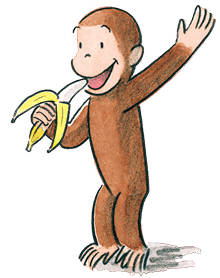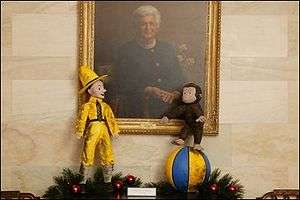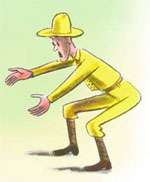Curious George
| Curious George | |
|---|---|
 | |
| First appearance | Cecily G. and the Nine Monkeys (1939) |
| Created by | Hans Augusto Rey and Margret Rey |
| Information | |
| Species | Monkey |
| Gender | Male |
Curious George is the main protagonist of a series of popular children's books by the same name, written by Hans Augusto Rey and Margret Rey. The books feature a curious brown monkey named George, who is brought from his home in Africa by "The Man with The Yellow Hat" to live with him in a big city.
When the first story, Cecily G. and the Nine Monkeys was published in France in 1939, George was named Fifi.[1] In the United Kingdom, George was originally called "Zozo" in 1941, apparently to avoid using the name of the then King George VI for a monkey.[1] Books featuring the adventures of Curious George have been translated from the original French into many other languages in addition to English. The books have been adapted into several television series and films.
Creation
The series was written and drawn by the team of Hans Augusto Rey and Margret Rey. The couple fled Paris in June 1940, on self-made bicycles, carrying the Curious George manuscript with them.[2][3] At first, only H. A. Rey was credited for the work in order to distinguish the Reys' books from the large number of children's books written by female authors. Later, Hans Rey was credited for the illustrations and Margret Rey for the writing. The Reys produced many other children's books, but the Curious George series was the most popular. Each book has been in continuous print since it was first published. The current United States publisher is Houghton Mifflin Harcourt of Boston Mass.
Books

Margret and H.A. Rey released seven "Curious George" books during H.A. Rey's lifetime. More recently, more Curious George books have been released by Houghton Mifflin Harcourt including board books with scenes from the original books, books adapted from the 1980s telefilm series, and new adventures.
"Original Adventures"
Curious George appeared in 1941. This book begins with George living in Africa and tells the story of his capture by the Man with the Yellow Hat, who takes him on a ship to "the big city" where he will live in the zoo. The second book, Curious George Takes a Job (1947), begins with George living in the zoo, from which he escapes and has several adventures before the Man with the Yellow Hat finds him and takes George to live at his house. The remaining stories tell of George's adventures while living at the house of the Man with the Yellow Hat.
Sometimes dubbed the "Original Adventures", these original seven titles are completely by the series creators, Margret & H.A. Rey.
- Curious George (1941)
- Curious George Takes a Job (1947)
- Curious George Rides a Bike (1952)
- Curious George Gets a Medal (1957)
- Curious George Flies a Kite (1958)
- Curious George Learns the Alphabet (1963)
- Curious George Goes to the Hospital (1966)
Before appearing in his own series, Curious George appeared as a character in another children's book written and illustrated by H.A. Rey, Cecily G. and the Nine Monkeys (1939).
Books adapted from telefilms
A second series of books, based on the telefilm series, was edited by Margret Rey and Alan J. Shalleck. These appeared between 1984 and 1993. They are mostly out of print, though several have been re-released with new cover art.
"New Adventures"
A third series of books, the Curious George "New Adventures," began to appear in 1998, and continues to the present. These books are "illustrated in the style of H. A. Rey" by a variety of credited and uncredited artists including Mary O'Keefe Young, Martha Weston, Anna Grossnickle Hines, Michael Jensen, and Vipah Interactive.
The Man with the Yellow Hat

Aside from George himself, the only recurring character in the original adventures is the unnamed Man with the Yellow Hat. It was he who lured George into a trap with his hat, captures him in a bag, and forcibly brought him from Africa, and in his house that George lives. The Man often facilitates George's adventures by taking him somewhere, and even more often resolves the tension by intervening just in time to get George out of a tight spot. He is always seen wearing a bright yellow suit and a wide-brimmed yellow hat. The Man is never mentioned by name in the original adventures or in any subsequent content over more than six decades.
He is always called either "The Man" or fully "The Man with the Yellow Hat". When people speak to George about the Man, they often refer to him as "Your friend", though the Man acts more like a father to George. However, in Curious George (2006), the Man is referred to as "Ted" throughout the film, and as "Ted Shackleford" in a deleted scene. Fifty years earlier, in an open-the-flap book titled See the Circus, published January 1, 1956, H. A. Rey illustrated a man who looks very much like the Man with the Yellow Hat wearing a blue and white polka-dotted kerchief. The caption for the page reads, "Ted has a tricycle, so very small, He cannot ride it, because he's so tall. If you want to find out WHO the rider will be, Just open the flap, and then you will see." Opening the flap reveals two monkeys riding a tricycle.
Other media
Television
There was a series of animated TV films made (beginning in 1980) featuring the character, which were then adapted into books themselves (making up part of the New Adventures series listed above). This series was produced and co-written by Alan Shalleck.
A series of Curious George animated shorts were aired on The Disney Channel as a segment on the program Lunch Box from the late 1980s into the 1990s.[4][5] On Playhouse Disney, Jack Duffy narrated a 2D animated story version of Curious George which had different episodes from the book series that were written by H.A. Rey and Margret Rey. It was part of a story time segment called Circle Time which aired on TV between 1997 and 2001.
A new Curious George debuted September 4, 2006, on PBS Kids as part of PBS Kids Preschool Block. Curious George is still airing on PBS Kids. It is produced by the Boston affiliate WGBH and Universal Pictures.
Film
Two stop-motion animated shorts were made of two Curious George stories Curious George and Curious George Goes to the Hospital in 1982,[6] created with puppet-figures by noted animator John Clark Matthews (who later used a similar technique for his films of Frog and Toad).[7]
An animated film, Curious George, featuring Will Ferrell as the voice of the originally unnamed Man With the Yellow Hat, was released on February 10, 2006. In this film (in which The Man is referred to as "Ted"), Curious George secretly follows The Man onto the ship to the city on his own accord. Frank Welker provided the vocal effects of Curious George. On March 2, 2010, a direct-to-video sequel to the film was released, titled Curious George 2: Follow That Monkey!, which featured Jeff Bennett replacing Ferrell as the voice of the Man. Bennett also provides the Man's voice in the TV series. The second direct-to-video sequel, Curious George 3: Back to the Jungle, was released on June 23, 2015.[8]
A Christmas film, Curious George: A Very Monkey Christmas, was released in 2009 on PBS.
A live-action/computer-animated film was in development at Illumination Entertainment in the early 2010s.[9][10] In August 2016, it was reported that Andrew Adamson was in negotiations to direct, co-write and executive produce a live-action film for Universal Pictures, along with Ron Howard, Brian Grazer, David Kirschner, Jon Shapiro and Erica Huggins producing.[11]
Video game
There is also a Curious George video game that was released on February 2, 2006, published by Namco and developed by Monkey Bar Games, a division of Vicious Cycle Software for Microsoft Windows, Xbox, GameCube, PlayStation 2, and Game Boy Advance. It was supposed to be released on Nintendo DS but it was cancelled.
Other
A children's bookstore in Harvard Square, Cambridge, Massachusetts, was known as Curious George and Friends (formerly Curious George Goes To Wordsworth), and carried a considerable amount of licensed Curious George merchandise. It was the last remaining property of Wordsworth Books, a former local general-interest bookstore that closed in the early 2000s. This store was closed in June 2011.[12] A new store opened in 2012 at the same address, called The World's Only Curious George Store, Harvard Square.
VEE Corporation, the company behind Sesame Street Live, is mounting Curious George Live.[13] It is a brand new national tour featuring song and dance and Curious George himself. It is based on the PBS animated series.
Curious George is used as the theme for children's play areas and some of the children's entertainment on the Stena Line ferries.[14] On some peak time sailings this includes a Curious George costumed character. Curious George merchandise is also provided with children's meals and is available to purchase in the on-board shop.
A Curious George themed waterplay area called Curious George Goes to Town has been a minor attraction at Universal Studios Florida since 1998. The attraction also featured at Universal Studios Hollywood until its removal in 2013.
In mid-2006, the Curious George brand joined with Welch's jelly for a collectible of six jars. In the latter part of that decade (when the new film and the new television show were released), licensing deals for the character generally involved less upscale, more kid-focused products.[15] Earlier, Vivendi Universal (now NBCUniversal) had, for a short time, embraced the use of the character in a series of 2001 ads for the company (but the character never officially became a corporate mascot).[15]
In the 1994 film Forrest Gump, one edition of Curious George (one with a yellow cover but no other title than Curious George) is used as Forrest's favorite book, which his mother reads to him. In the opening scene a feather comes floating down to Forrest's feet and he stores it in this book. At the end of the film it falls out of the book and rises floating through the air again.
Jarrod, the titular character and protagonist from the NBC series The Pretender, read Curious George books in Season One and developed a fascination with them. He likened himself to George and Sydney Green, the psychiatrist whom he saw as a surrogate father, to the Man with the Yellow Hat.
The books have inspired others, for example Bangkok Bob written for and published by Big Brother Mouse, a Lao publishing project.
Curious George in translation
The character has been translated variously into other languages:
- Afrikaans: "Eienaardige George"
- Danish: Peter Pedal
- Dutch: Nieuwsgierig Aapje
- Finnish: Utelias Vili
- French: Georges le singe
- German: Coco
- Galician: "Golgol"
- Hebrew: ג׳ורג׳ הסקרן (tr. George HaSakran)[16]
- Hungarian: Bajkeverő majom ("troublemaker monkey")
- Italian: Curioso come George
- Icelandic: "Forvitinn George"
- Japanese: おさるのジョージ (tr. Osaru no Jõji)
- Macedonian: Лјубпинти Дзордз (tr. Ljubopitni Džordž
- Korean: 호기심많은조지 (tr. Hogisim Maneun Joji)
- Norwegian: Nysgjerrige Nils
- Portuguese: George, o Curioso
- Spanish: Jorge el Curioso
- Swedish: Nicke Nyfiken
- Yiddish: דזשארדזש דער נייגעריקער (tr. Dzshordzsh der naygeriḳer))
See also
References
- 1 2 "Curious George . About the Reys". Retrieved 2008-03-10.
- ↑ "Boston.com News, By Mark Feeney Globe Staff". The Boston Globe. September 17, 2005. Retrieved 2007-10-29.
- ↑ "New York Times, By Dinitia Smith". The New York Times. September 13, 2005. Retrieved 2007-10-29.
- ↑ The Disney Channel Magazine, Vol. 7, no. 5, September/October 1989: p. 41.
- ↑ The Disney Channel Magazine, Vol. 9, no. 6, November/December 1991: p. 34.
- ↑
- ↑ See samples on John Clarke Matthews' website, also available as a DVD / VHS, including the Frog and Toad animations - "Curious George Comes To America" ASIN: B00062J0OE
- ↑ "Curious George 3: Back to the Jungle". Universal Studios Home Entertainment. Retrieved May 7, 2015.
- ↑ Zeitchik, Steven (July 30, 2010). "With 'Curious George,' Illumination looks to make more animation mischief". Los Angeles Times. Retrieved July 31, 2010.
- ↑ Debruge, Peter (November 17, 2015). "'Minions' and Illumination Create a Blockbuster Animation Unit for Universal". Variety. Retrieved November 20, 2015.
- ↑ Fleming, Jr, Mike (August 8, 2016). "Andrew Adamson To Direct Live-Action 'Curious George' For Universal". Deadline.
- ↑ Curious George story ending as Harvard Square shop loses lease, Boston Herald, June 7, 2011
- ↑ Curious George Live
- ↑ Stena Line Curious George
- 1 2 Kilday, Gregg (2006-02-03). "The curious saga of George's big-screen gig". The Macon Daily (article from The Hollywood Reporter). Retrieved 2010-05-10.
- ↑ Melamed, Ariana. "The Curious Monkey that Kids Gotta Love" (in Hebrew). Retrieved 3 January 2016.
External links
| Wikimedia Commons has media related to Curious George. |
Others
- "Curious George Saves the Day: The Art of Margret and H.A. Rey" Exhibition in The Jewish Museum New York
- Wall Street Journal on Curious George
- Curriculum material for educators Curious George Saves the Day
- 1980 Television Series